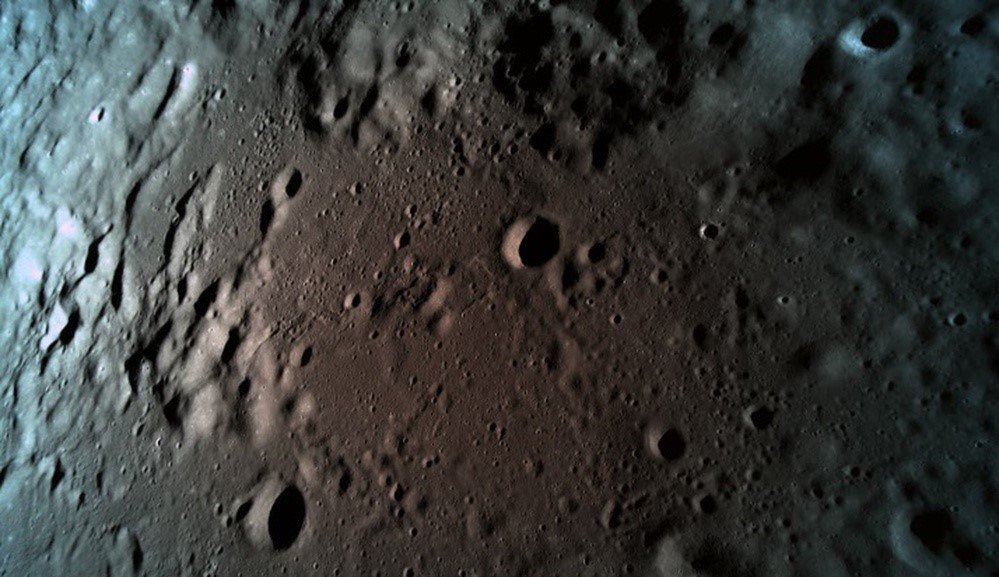
Beresheet's farewell photo shows the battered patch of lunar ground that would become the little probe's final resting place.
The privately funded Israeli moon lander, whose name means "in the beginning" in Hebrew, crashed during its historic touchdown bid on April 11 after suffering an engine glitch. The problem apparently began with a manually entered command, which led to a regrettable chain reaction, Beresheet's handlers have said.
And now we know what Beresheet was looking at during its last moments, thanks to a photo released yesterday (April 17) by the nonprofit organization SpaceIL, which ran the moon mission along with the company Israel Aerospace Industries (IAI).
Related: Israel's 1st Moon Lander Beresheet in Pictures
"This is the last picture that Beresheet took, at a distance of 15 kilometers [9.3 miles] from the surface of the moon," SpaceIL representatives said yesterday via Twitter, where they posted the image.
This is the last picture that Beresheet took, at a distance of 15 kilometers from the surface of the Moon.#Beresheet #SpaceIL pic.twitter.com/fGhNkvg5QdApril 17, 2019
The photo is apparently not the last one that Beresheet beamed home, however; that distinction goes to a shot taken earlier, at a different angle, which shows the moon's limb against the blackness of space. According to Israeli diplomat Elad Ratson, the probe transmitted this latter picture when it was just 4.7 miles (7.5 km) above the lunar surface.
Beresheet launched to Earth orbit atop a SpaceX Falcon 9 rocket on Feb. 21. Over the next six weeks, the 5-foot-tall (1.5 meters) lander performed a series of engine burns to spiral outward, closer and closer to the moon.
Get the Space.com Newsletter
Breaking space news, the latest updates on rocket launches, skywatching events and more!
Those maneuvers paid off on April 4, when Israel became just the seventh nation to put a spacecraft into orbit around the moon.
Got 2ⁿᵈ confirmation from @ILAerospaceIAI. This is the l̲a̲s̲t̲ image #Beresheet sent to earth before it crashed! Telemetry of moment it was taken not available yet, however, image received in mission control when Beresheet was 7.5㎞ above moon surface🔗https://t.co/Hq9cSgm9JA pic.twitter.com/9UPQ5jeSZvApril 12, 2019
Beresheet tried for even more-rarefied air on April 11. To date, only three nations — the Soviet Union, the United States and China — have pulled off a soft touchdown on the moon. And all of those successful missions were government efforts; Beresheet was trying to become the first-ever private spacecraft to accomplish the feat.
The Israeli mission was doing it all on the relative cheap as well. Beresheet's total price, including launch, was about $100 million, SpaceIL team members have said. (SpaceIL formed in 2011 to compete in the Google Lunar X Prize, a $30 million private race to the moon. The GLXP ended last year without a winner, but work on Beresheet continued.)
And Israel's moon dreams did not end on April 11. SpaceIL and IAI have already begun planning a Beresheet 2.0 mission, SpaceIL President Morris Kahn announced over the weekend.
- Israel's 1st Moon Lander: The SpaceIL Beresheet Lunar Mission in Pictures
- Space Is Hard, Beresheet Israeli Lunar Crash Proves Again
- Israeli Moon Lander Snaps Epic Space Selfie with a Full Earth
Mike Wall's book about the search for alien life, "Out There" (Grand Central Publishing, 2018; illustrated by Karl Tate), is out now. Follow him on Twitter @michaeldwall. Follow us on Twitter @Spacedotcom or Facebook.
Join our Space Forums to keep talking space on the latest missions, night sky and more! And if you have a news tip, correction or comment, let us know at: community@space.com.

Michael Wall is a Senior Space Writer with Space.com and joined the team in 2010. He primarily covers exoplanets, spaceflight and military space, but has been known to dabble in the space art beat. His book about the search for alien life, "Out There," was published on Nov. 13, 2018. Before becoming a science writer, Michael worked as a herpetologist and wildlife biologist. He has a Ph.D. in evolutionary biology from the University of Sydney, Australia, a bachelor's degree from the University of Arizona, and a graduate certificate in science writing from the University of California, Santa Cruz. To find out what his latest project is, you can follow Michael on Twitter.









